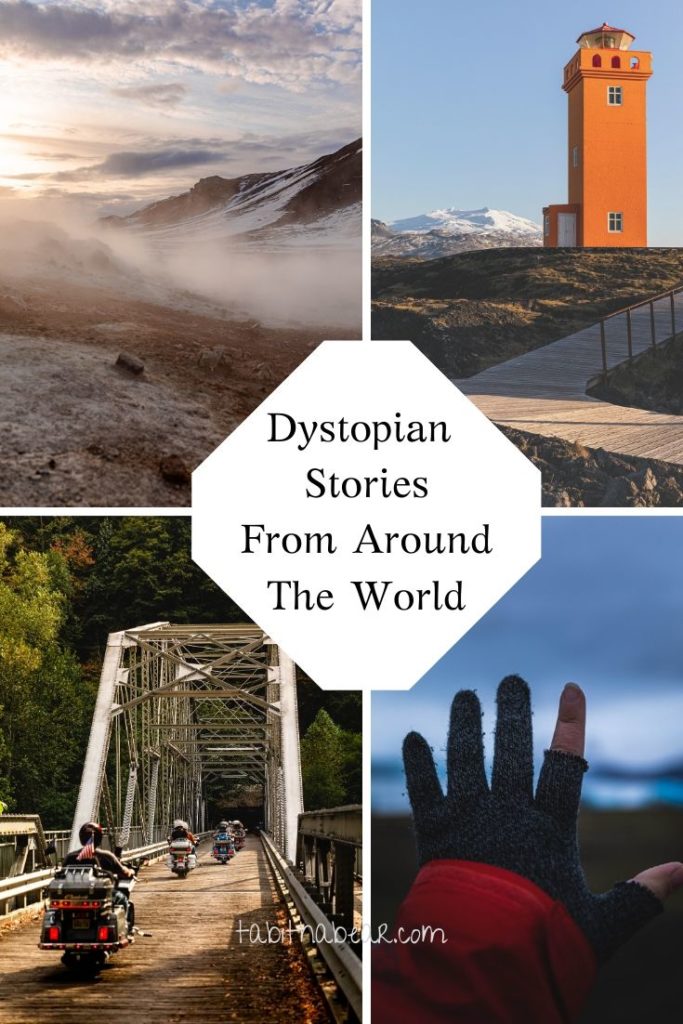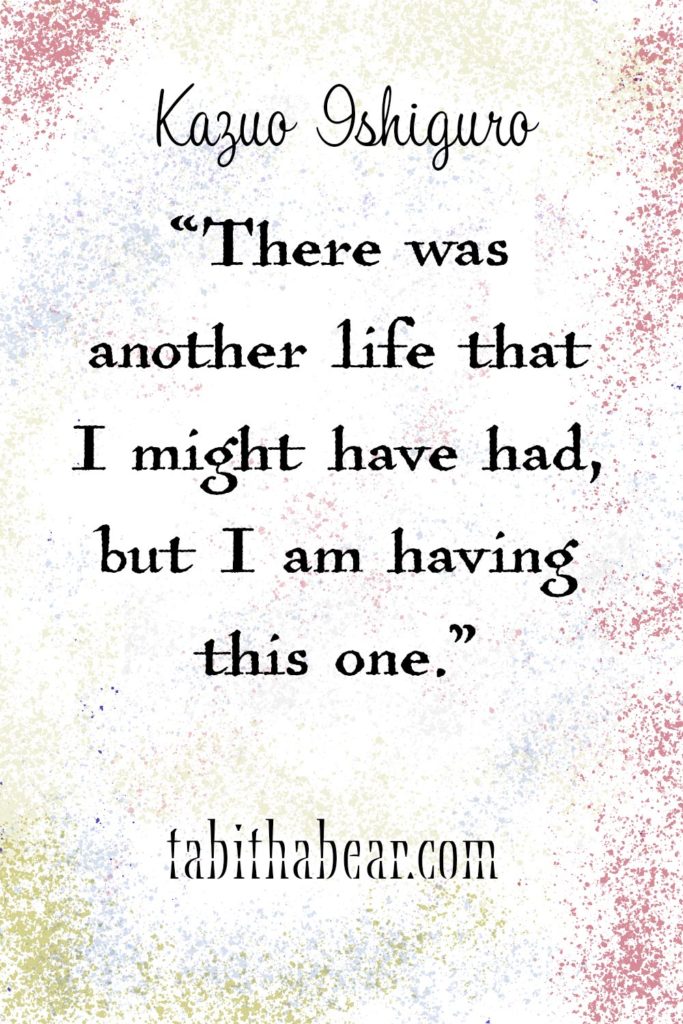Dystopian Stories From Around the World Part I
This has been one of the easiest lists to create. I’m a huge fan of dystopian stories – arguably speculative, at times – fiction. As I was composing this list, I realized the pattern of human reproduction as an element to drive a dystopian universe is rather high. Whether it is a question of women’s fertility, purposeful procreation of children for alternative uses, or the need for women to ultra procreate because the ratio of women to men is off, it’s a bit astounding.
Because of this realization, I made an attempt to cut out a few of those stories to broaden the dystopian scope and unintentionally made a list of recent publications. I know this is a disservice to the dystopic literature world, so I decided to make this post a Part I. I will definitely revisit the topic with older titles.

There was another life that I might have had, but I am having this one.
Kazuo Ishiguro

This post may contain affiliate links. I am an affiliate of Bookshop.org and Amazon. Bookshop supplies books from independent bookstores and is only (currently) available to US shipping addresses.
The Machine Stops, 1909 – EM Forster
The first time I read this was as an assignment from a college professor. It absolutely blew my mind. It’s a short(er) story/novella. It focuses on humans living underground and cared for by machines. They filter clean air, feed them, and people spend their days face-timing with friends from their rooms. The machines also attack anyone who tries to leave this community.
But why did this blow my mind?
Double check the date up there, friend ^. It was published in nineteen-oh-nine.
This story also makes me think about the distraction of useless numbers to help us feel fulfilled.
When EM Forster published this story, the big thing was calling cards. If someone came by your house, and you were gone, they’d leave a calling card to let you know they’d been there so you could seek them out. And so began the trend of people saving their calling cards and flaunting them about when they had company with a ‘Look at how many calling cards I have. Look at how popular I am.’
Part two why this blew my mind: over a hundred years later, we still do this! With followers, likes, monthly views…
Let’s move on before I start to rant about my obsession with monthly views for income purposes… (Insert upside down smiley face.)
(Insert massive gratitude for your readership.)
Great thing about this story being so old, it’s easy to find it for free online!
Eighteen O’clock Music Bath, 1937 – Juza Unno
Eternal life is achieved for humans. Yippee, AMIRITE?! Everyone can do whatever they want, except for one hour every day, they must be productive at a superhuman speed. This is aided by an hour of music chosen by the government, but it has extra side effects other than speed.
Juza Unno has a lot of science fiction work to choose from. He’s considered the father of Japanese science fiction and lived during an incredible time. He was influenced by Nikola Tesla, and was heavily affected by WWII.
I’m partial to stories written between the 1920’s – 1950’s, too. (Which may be a fun fact I share about myself often enough on here.)
Updated January 2022 – this is no longer available on Amazon. The Skeleton House is.
Never Let Me Go, 2005 – Kazuo Ishiguio
This may be a popular suggestion, but it’s just such a beautiful story. This has been adapted into a film starring Keira Knightley and Carey Mulligan and also a Japanese television drama. So if you haven’t read it, there’s a chance you’re familiar with the film or TV show.
The storyline revolves around a handful of specific characters and their experiences at school as they grew up, but there is something not quite right with the school, and why these children even exist.
It’s lovely and heartbreaking.
The Repossession Mambo, 2009 – Eric Garcia
I grabbed this book when it first came out and it was a wild ride. It became a movie (Repo Men) rather quickly after it was published, too.
In a not-so-distant future, people live longer, healthier lives thanks to artificial organs. Cancer is less of an issue. Faulty organs at birth are no longer a problem. But the co$t is overwhelming. If anyone falls behind on payments, the organs are repossessed, and not kindly, either.
This book feels so very much on the brink of reality, it’s one of those frighteningly awesome dystopian stories.
The Girl in the Road, 2014 – Monica Byrne
I don’t even recall how I came to own this book. And I’ve had it since it first came out. From a reader’s perspective, this book is weird AF. And only gets weirder as the story progresses. Please don’t let this discourage you whatsoever. But, I think it’s important to have that kind of disclaimer because there is some deep symbolism within this story and, for me, I know I need to be in a certain state of mind and focus to deal with books like this.
From a traveling writer’s perspective, I love knowing how much traveling and culture immersion Monica did while she was writing this book. It shows and it’s lovely.
The story follows two different women at pinnacle points in their lives. It’s a time on Earth when the sea level has risen a great amount, and humankind has uprooted it’s life to higher ground, causing a mesh of culture, languages, etc. It’s really interesting to see what she’s done with people just by asking the question, ‘What if the all the glaciers really do melt?’. It certainly goes into greater depth from there, but I cannot do the symbolic weirdness any justice with terrible paraphrasing.
Welcome to Orphancorp, 2015 – Marlee Jane Ward
Orphans are an industry and used as free labor. It dives into their treatment while used as a labor force, versus the love they find within each other. It explores what love really is and explored on different levels of intimacy throughout the book.
It’s a quick read, but it packs a wallop. It makes you think about human nature and how we treat each other.
The Marrow Thieves, 2017 – Cherie Dimaline
People have lost the ability to dream, except for Indigenous people, who are hunted down so their bone marrow can be harvested. Their bone marrow is used in a treatment to help those who cannot dream.
This book speaks to me on a more personal level. I’m Lenape and there’s a lot of family history, and current events, that make me and my family feel a certain way. This story manages to dive into that and shares an indigenous story that needs to be told.
An Excess Male, 2017 – Maggie Shen King
Inspired by the all-too-real one-child policy in China, Maggie writes about near-future impacts. Women take multiple husbands because there are far too many men without families. There is a test of patriotic duty and an exploration of gender [roles] and marriage.
This is one of those dystopian stories that’s rather uncanny as to how believable it is.

Before She Sleeps, 2018 – Bina Shah
This might start out to sound like An Excess Male – the story takes place in Asia, and women are forced to take multiple husbands. However – this story focuses on the women who refuse to be a part of this government controlled system, and their life off-the-grid.
It’s an underground feminist community fighting the injustice of their bodies controlled by the government.
Sound familiar…?
Recruitment, 2019 – K.A. Riley
Regardless of birthdate, everyone shares the same birthday on November 1st. And when children turn seventeen, the Recruiters come and take them away, and they’re never seen again. Everyone is told the recruits are to help fight the war against the Eastern Order. The story follows the new draftees going through military training and other experiences that don’t make any sense.
In case you haven’t picked up on it – this is a young adult book! They’re not for everyone, of course. Or sometimes, we’re not in the mood for mild bouts of teenage angst. But this is a unique start to Riley’s Resistance Trilogy.
Have You read any of these dystopian stories?
Find more book recommendations here (<- link)!

Pingback: 30 Indigenous Authors to Read - Tabitha Bear